
If it’s raining, you wear a raincoat or carry an umbrella when you go outside. If it’s cold, you bundle up in a coat. If it’s hot, you wear shorts and a T-shirt. You dress for the situation.
The same thought process can be applied to specifying the ideal steel roof deck for building projects. Massive warehouses might be best addressed with a different type of steel roof deck than that of a small retail space. New-construction projects have demands that a historic conversion do not. A building project on the Gulf Coast of Texas might require steel roof deck that meets different requirements than one in Chicago.
Steel roof deck is separated into two main categories: Specialty steel roof deck and standard steel roof deck. Each category is made up of several types of deck that are attractive to a range of project types.
So what steel roof deck is best for your project? It depends.
This category includes two main types of deck: Deep-Dek® and Versa-Dek®. Generally, specialty deck is used on more complex projects with particularly unique demands and to meet aesthetic needs.
A deep-ribbed steel roof deck, Deep-Dek creates the longest spans of any profile (up to 35 feet) with a dramatic aesthetic appeal ideal for projects with wide-open spaces. Its unique shape produces Deep-Dek’s strength and dramatic deep-fluted appearance when left exposed. In an optional cellular configuration, Deep-Dek has a smooth underside look with subtle shadow lines.
Because of its strength and appearance, Deep-Dek is well-suited for projects with long, open interior or exterior spaces and overhangs, such as schools; stadiums and recreation centers; airports and transportation facilities; and civic and event centers.
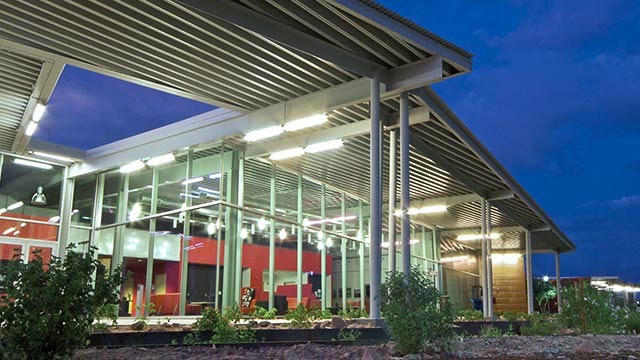

Deep-Dek spans the interior to the exterior of this college campus expansion in the Arizona desert.
Further benefits of Deep-Dek include achieving high noise reduction coefficient (NRC) values with cellular acoustic options and seamlessly integrating utilities in the cavities of the deck’s shape.
Glendale Community College in Arizona features Deep-Dek that flows from the interior to the exterior, creating an elegant indoor-to-outdoor transition. The effect appears seamless with the integration of a window wall system that rises to the underside of the roof deck. The deep-ribbed, long-span decking minimizes connections to structural members, which are carefully considered to not compromise views.
Versa-Dek is a dovetail roof deck that produces an appealing linear plank look while bolstering the cost-efficiency and structural performance of building projects. The dovetail design hides unsightly roof fasteners no matter the roofing assembly. An acoustic option provides high NRC values for sound absorption.
The unique dovetail shape of the deck gives Versa-Dek its strength, enabling it to achieve long spans or overhangs necessary for projects with open interior or exterior spaces. Its signature shape also can be used to integrate non-piercing wedge hangers to suspend ceiling-mounted elements such as utilities and fire-suppression lines.

Photo courtesy of Las Vegas Convention and Visitors Authority
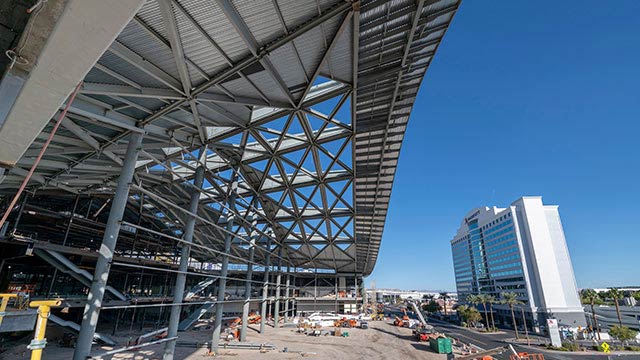
Versa-Dek 2.0 LS ES acoustical roof deck, which features batting in the dovetail deck’s cavities, cuts down on noise in the spacious Las Vegas Convention Center West Hall.
Thanks to its pleasing look and acoustic options, Versa-Dek eliminates the need for secondary ceiling systems like acoustical ceiling tile grid and componentry. This saves on material expenses and the labor associated with ceiling installation.
In the recent expansion of the Las Vegas Convention Center, a dovetail roof deck with acoustic treatments makes up the ceiling of a gargantuan 600,000-square-foot exhibit hall. Using Versa-Dek 2.0 LS ES acoustical roof deck, the project team achieved NRC ratings of .90, which will help control noise during crowded conventions.
As its name suggests, standard steel roof deck is used on projects with fewer or less-complex demands or when aesthetics are not a consideration. More specifically, standard deck typically is not left exposed. It is often concealed with a secondary ceiling system, such as a drop ceiling. This category of deck includes several types of steel roof deck.
Type 1.0 roof deck is an economical, lightweight deck commonly used in projects over light-gauge steel framing, whether structural steel studs or cold-formed steel trusses. An economical roof deck solution, 1.0 roof deck often is used in framing spaced up to 4 feet on center.
Typical uses of 1.0 deck include schools, offices, banks, retail or other small projects, many of them with pitched roofs or roofs with a lot of ridges and valleys. Its main benefit is its cost-effectiveness in meeting project requirements.
F deck is an intermediate-rib roof deck that is an economical choice but gets beat out by its better, similar counterpart, B deck. Joe Voigt, marketing manager at New Millennium, says F deck is usually called on in retro-fit projects to match existing F deck.
Type B deck is the most commonly used roof deck, Voigt says, in large part because it provides the best balance of strength and economy. Featuring wider rib spacing than F deck, B deck is available in a variety of options to meet multiple project needs. Standard or cellular, acoustic or vented, interlocking or nested side laps, B deck is among the most flexible of the 1½-inch-deep roof decks.
The most common roof deck, B deck is often found in warehouses, schools, and office buildings, although it is suitable for just about any building type, Voigt says.


Tualatin Hills Aquatic Center in Beaverton, Oregon, uses B deck to help control noise in the facility and create a linear ceiling aesthetic.
“Most projects have B deck on it because it’s the most cost-efficient, most readily available deck and has impressive span capabilities,” he says. “So it’s the most economical system, in general, with the most readily available materials.”
The project team responsible for the roof replacement at the Tualatin Hills Aquatic Center in Beaverton, Oregon, used an acoustic B deck to provide appealing aesthetics and control noise while staying on budget.
Capable of creating the longest clear spans of any standard deck profile, type N deck and NW32 deck make large open spaces possible by limiting the number of structural supporting members required.
NW32 and N deck are economical choices for open spaces such as schools, event centers and warehouses, with NW32 offering further benefits. At 32 inches wide, NW32 is 33 percent wider than standard N deck. Coverage is achieved with fewer panels, which means less labor, lower costs and faster installation.
For aesthetic appeal, type N deck is available in a cellular version that provides a finished underside ceiling with self-aligning side laps and concealed fasteners. Optional acoustic treatments enable N deck and NW32 deck to achieve NRCs of .95.
In Arlington, Texas, a specially painted N deck makes up part of the roof of Globe Life Field, the home of baseball’s Texas Rangers.
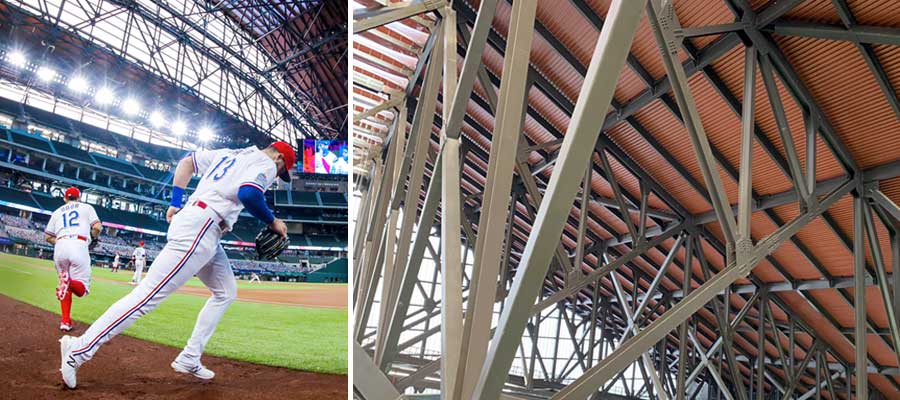
Photo courtesy of Kelly Gavin, Texas Rangers
The clay-colored N deck provides a solid background designed to make baseballs more visible during games at Globe Life Field.
Curve-Dek is a 3-inch-deep steel roof deck that is used over radiused framing to create unique and stunning roof and canopy applications. It has large span capabilities and can be specified in a cellular configuration for a smooth look. A curved building component, Curve-Dek provides concave or convex curvatures and is available with optional acoustical properties to meet challenging design requirements.
This architectural roof deck creates a smooth radius look without the need for special accommodations to the structural framing that would result in a less pleasing aesthetic. It gives design teams the tools to create innovative canopies, pavilions and unique rooflines.
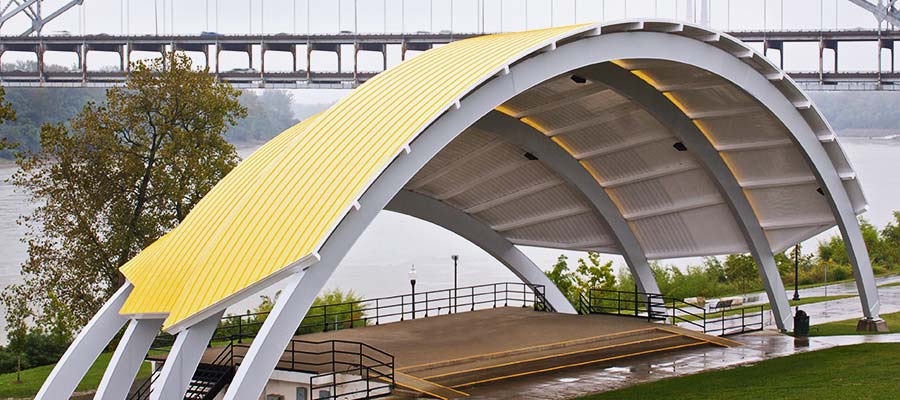
Curve-Dek creates a smooth, curving structure for New Albany Riverfront Amphitheater on the Ohio River in New Albany, Indiana.
At New Millennium, we help you achieve your architectural vision and realize a range of project and performance improvements. Our steel roof deck specialists have decades of practice in the industry and can offer you valuable guidance.
Find a steel roof deck to satisfy your project needs. Our options are ideal for a range of applications, from schools and multi-family residential to office complexes and warehouses/data centers. Go into deeper detail and gain more insights about our roof deck today.

Our new continuing education courses enable you to keep up to date with the latest practices in steel building systems.
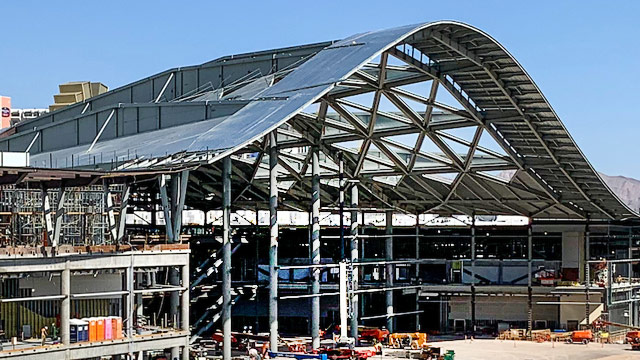
The Las Vegas Convention Center West Hall expansion features a majestic, curved roof made up of type N roof deck.
Building a better steel experience